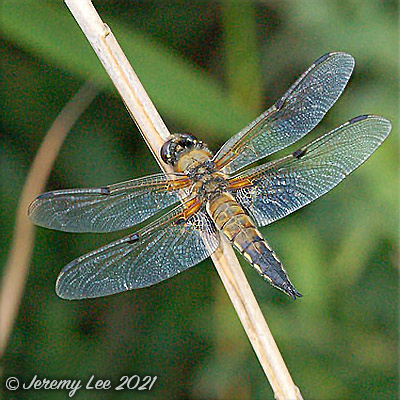
 |
|
Scientific Classifications explained » Amphibians » Ants » Aphids » Bees » Beetles » Birds » Bugs » Butterflies » Caterpillars » Damselflies » Dragonflies » Earwigs » Flies » Frog/Leafhoppers » Fungi » Galls » Grasshoppers » Harvestmen » Hoverflies » Lacewings » Ladybirds » Leaf Mines » Lichens » Mammals » Millipedes » Mosses » Moths » Sawflies » Slugs » Snails » Spiders » Trees » Wasps » Wild Flowers » Woodlice |
UK Nature > Dragonflies > Libellula quadrimaculata

Scientific Name: Libellula quadrimaculata Common Name: Four-spotted Chaser Libellula quadrimaculata, more commonly known as the Four-spotted Chaser, is a medium sized dragonfly with body length about 25-35 mm. Both sexes have a brown ground colour becoming darker over the head and almost orange on the thorax sides. The posterior half of the abdomen is black with the sides of the abdomen edged yellow. The wings are suffused bright amber at their bases and both fore and hind wings have a dark patch about half way along their leading edges and a pronounced black stigma near the wing tips hence the common name of this chaser. There is also a black triangular patch immediately behind the amber suffusion of the hind wings. Male Four-spotted Chasers aggressively defend their territories from prominent perches around the margins of pools and ponds and ward off any intruders. Mating takes place in the air and the female lays her eggs in floating vegetation. This species prefers warm sites with ponds or ditches with still or slowly moving water. |
|

https://www.uknature.co.uk is a website dedicated to showing the immense diversity of UK nature and wildlife. Our vast range of habitats, from lowland arable to snow covered mountains, from storm-ravaged coastlines to peaceful inland freshwater lakes and rivers, from dry, sandy heaths to deciduous and coniferous forests, all these habitats contribute to the abundance of UK nature. We have wild birds in huge numbers either residing or visiting our shores (597 recorded species as at July 2013) and we must also not forget the humble back garden with its grass lawns, flower beds filled with nectar rich flowers, shrubs and trees, all designed to attract huge numbers of insects such as bees, moths, butterflies and hoverflies; and finally the small ponds which provide safe havens for frogs, toads, newts and even slow worms and grass snakes. www.uknature.co.uk is the showcase for my personal passion, photographing uknature in all its glory. I sincerely hope you all enjoy the fruits of my labours. This site and all images contained therein is © Jeremy Lee 2004 - 2021. All Rights Reserved. Site design by Jeremy Lee. Site development & IT Support by Stuart Lee. |